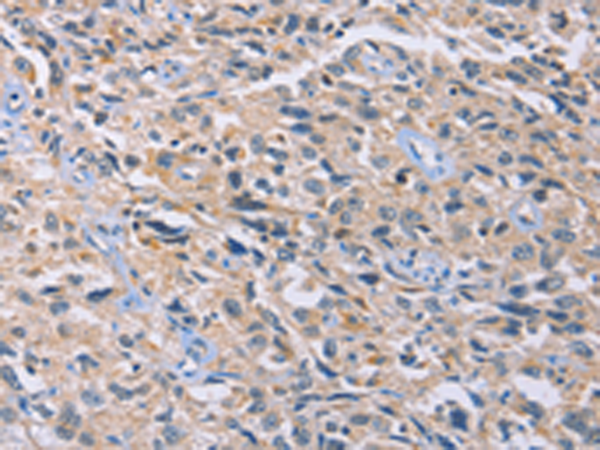


| WB | 1/200-1/1000 | Human,Mouse,Rat |
| IF | 咨询技术 | Human,Mouse,Rat |
| IHC | 1/25-1/100 | Human,Mouse,Rat |
| ICC | 技术咨询 | Human,Mouse,Rat |
| FCM | 咨询技术 | Human,Mouse,Rat |
| Elisa | 1/1000-1/2000 | Human,Mouse,Rat |
| Aliases | GB5 |
| WB Predicted band size | 44 kDa |
| Host/Isotype | Rabbit IgG |
| Antibody Type | Primary antibody |
| Storage | Store at 4°C short term. Aliquot and store at -20°C long term. Avoid freeze/thaw cycles. |
| Species Reactivity | Human, Mouse, Rat |
| Immunogen | Fusion protein of human GNB5 |
| Formulation | Purified antibody in PBS with 0.05% sodium azide and 50% glycerol. |
+ +
以下是关于GNB5抗体的3篇参考文献示例(基于公开信息概括,部分内容可能需结合具体文献核实):
---
1. **文献名称**: *"GNB5 mutations cause a novel syndrome with intellectual disability and autonomic nervous system dysfunction"*
**作者**: Lodder EM, et al.
**摘要**: 研究通过全外显子测序发现GNB5基因突变与神经发育障碍及自主神经功能异常相关,利用GNB5抗体在小鼠模型中验证蛋白表达缺失,揭示了GNB5在神经信号传导中的关键作用。
2. **文献名称**: *"G protein β5 subunit regulates cardiac electrophysiology and arrhythmia risk"*
**作者**: Wang Q, et al.
**摘要**: 文章通过免疫印迹(使用GNB5特异性抗体)和电生理实验,证明GNB5通过调节离子通道影响心脏动作电位,其缺失导致小鼠心律失常表型,提示GNB5在心脏疾病中的潜在治疗靶点。
3. **文献名称**: *"Antibody-based profiling of Gβ5 protein complexes in the brain"*
**作者**: Zhang JH, et al.
**摘要**: 研究开发了高特异性GNB5抗体,结合免疫共沉淀技术解析了Gβ5与RGS蛋白复合物在脑组织中的相互作用网络,为研究G蛋白信号通路提供了工具。
---
(注:以上文献信息为示例性质,实际引用请以PubMed或学术数据库检索结果为准。)
The GNB5 antibody is a crucial tool for studying the G protein subunit beta 5 (GNB5), a member of the heterotrimeric G-protein β-subunit family. GNB5 plays a unique role in signal transduction, particularly in regulating G-protein-coupled receptor (GPCR) pathways. Unlike other β-subunits, GNB5 preferentially interacts with regulator of G-protein signaling (RGS) proteins, forming complexes that modulate neurotransmitter and hormone signaling. This interaction is critical for controlling ion channel activity and neuronal communication.
Mutations in the GNB5 gene are linked to human diseases, including cardiac arrhythmias (e.g., sick sinus syndrome) and neurodevelopmental disorders characterized by intellectual disability, seizures, and delayed motor development. GNB5 antibodies are widely used in research to detect protein expression, localization, and interactions in tissues or cultured cells via techniques like Western blotting, immunohistochemistry (IHC), and co-immunoprecipitation (Co-IP). These antibodies aid in elucidating GNB5's tissue-specific roles and its pathological mechanisms.
Validating antibody specificity is essential, as GNB5 shares structural homology with other β-subunits. Research utilizing GNB5 antibodies contributes to understanding its dual role in cardiac and neurological health, offering potential insights for therapeutic strategies targeting GPCR-related disorders.
×